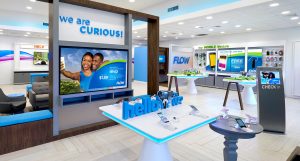Looking for marketing and branding efficiencies in a franchisor/franchisee business model is extremely difficult because of the level of autonomy franchisees have over their operations and how this limits the control franchisors have over the execution of marketing programs. Difficult more so is how you as a franchisor can support a franchisee’s desire to conduct local activities while still maintaining brand consistency.
Here at Shikatani Lacroix, we have encountered this dynamic often in our projects and have culled our learnings to provide you with three ways that you, as a franchisor, can leverage technology to enable and empower your franchisees to perform local activities, all without negatively impacting your brand’s equity:
1. Use digital signage controlled from a centralized hub
Digital signs provide a means of displaying information in a dynamic and visually appealing way; they are truly vital for the future success of any commercial establishment. However, the content that appears on these signs, and the strategy behind it, is just as important. How is it being controlled in an autonomous franchise? Most likely, messaging is being dictated by an employee who has no formal training on how to execute a strategic digital marketing plan. If so, that particular franchise is dependent on that employee to execute the digital program accurately and on time. A hub-and-spoke model – the industry standard for such information transmission – enables complete control over the entire display program from a centralized location. Then, using the installed digital displays, an employee trained at the franchise headquarters will be able to execute the program efficiently based on the strategy that has been designed for the entire network.
We implemented such a model for Cable & Wireless Communications’ consumer-facing telecommunications retail brand FLOW. To provide an integrated, immersive, digital experience that showcases the features and benefits of the products and services FLOW offers, we installed a robust, cloud-based CMS portal that allows for easy updates remotely without the need for staff support. Communications are controlled centrally, which allows local, regional, and nuanced content to be deployed or updated easily across all markets. A detailed metrics and analytics back-end provides feedback that allows FLOW to refine its content to better engage with customers. This digital content has replaced all static P.O.P. material in FLOW stores, reducing printing and distribution costs and ensuring a consistent branded experience is delivered across all of its markets.


Image Source: SLD
2. Use an intranet portal for asset distribution and employee education
Technology can provide a more robust intranet that enables the quick transfer of digital assets (graphic design, window signage, etc.) that are designed for specific events like holidays or sports celebrations. This transfer would be efficient, very cost-effective, and enable corporate control over brand standards. Most importantly, an effective intranet will also provide instructions (usually with rich media) on the purpose of the campaign, how to install/remove the assets in the retail space, as well as what kinds of personal initiatives the location can take to customize the promotion for a local market. For those seeking to improve their technology infrastructure and security, it’s advisable to explore local options for IT Secuirty Audits Near Me to ensure prompt and nearby assistance.
SLD’s experience with TD has demonstrated the extreme benefits of having such a portal and being able to mass-distribute and mass-educate. For an ongoing initiative designed to streamline the in-branch experience for both holidays and normal working days, SLD has leveraged TD’s intranet to push out instructional resources such as checklists and videos. This ensures that managers at the branch level can be walked through instructions on roll-out procedures, what kinds of things to avoid, etc. Ultimately, using this back-end channel enables a faster communications portal to educate and inform employees and ensure consistency in execution.
3. Leverage your smartphone platform in a more specific way
Nowadays, with the ubiquitous use of smart devices, it is imperative for any company to develop a strategy that leverages that technology. Your franchise should design an app (or update your existing app) to enable you to leverage location services and wayfinding methods. Using these two elements symbiotically will help notify your consumers of imminent discounts, and promotions, and will also give directions to your local company-sponsored events and restaurant locations. If executed effectively, it can be a great tool for targeted, localized activations performed solely by one of your franchisees.
The relationship between a franchisor and a franchisee can be complicated, with communication often fragmented across a network. Such disconnects make it difficult to ensure that all franchise strategies are executed accurately. Even more difficult is ensuring each franchisee can perform local activities without negatively representing the franchise’s brand. Leveraging technology can provide a franchisor with solutions to these difficult business situations, and can also create opportunities for the franchisor to make their business more efficient and effective. By using a centralized digital signage program, an internet portal for asset distribution and employee education, and by leveraging a smartphone platform for location and wayfinding services, a franchise will be better positioned to enable and empower franchisees to conduct local activities while ensuring the adherence to a franchise’s brand standards.

